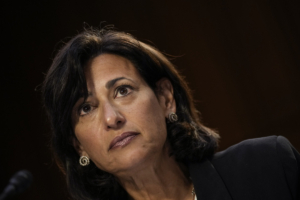
Explaining ‘Fast-Moving Science’ in Plain Words with Pictures
When Dr. Rochelle Walensky became director of the Centers for Disease Control (CDC) during the COVID-19 pandemic, one of her first actions was to engage a media consultant. She and the agency she heads were under fire for sending out conflicting and often confounding messages about masks and vaccinations, the product of an agency dealing in real-time with scientific facts and political demands.
“I think [CDC] is being way too careful,” a former senior Biden administration official said last year. “They’re smart people and they’re guilty of being a little bit in a bubble and overthinking their messaging.”
Walensky’s commitment to do a better job or communicating public health led to an agency review that found CDC’s centers, institutes and offices “too often work in silos” and work at the pace of “academic research”. “CDC has deep subject matter expertise across the agency,” the analysis says, but would benefit from “being nimbler and more flexible”.
“The agency’s critical cross-cutting functions and core capabilities (health equity, communications and policy) have been woefully underfunded,” the analysis reported, “and their presence within the organization has been de-emphasized in comparison to disease-specific subject matter expertise.”
“It is critically important to have a strong public health foundational infrastructure – with a complementary CDC structure – prepared for any next [public health] threat,” the analysis concluded.
The internal analysis produced five recommendations, many of which will be familiar to communication professionals and instructive for organizations that communicate sophisticated information to a variety of audiences. Five recommendations undergird the new initiative called CDC Moving Forward:
- Share science and data faster
- Translate science into practical policy
- Prioritize public health communications, with a focus on the American public
- Develop a CDC workforce ready to respond to future threats
- Promote partnerships
Sharing Science Faster
CDC should release scientific findings sooner with proper qualifications, including the level of confidence in the findings prior to further study. CDC also should accelerate its review process in light of public health emergency trends by engaging non-agency reviewers and reducing internal agency levels of review.
 Making Science Understandable
Making Science Understandable
In response to pandemic-era guidance documents that were long, overly complex and dotted with caveats, the analysis recommends developing a standardized process, including communication professionals, to evaluate new findings and prepare comprehensible policy advice and general public health information. A feedback loop should be used to measure “clarity, ease of implementation, timeliness and resultant outcomes” of CDC advice on intended audiences.
The objective of the process is to “produce plain language, easy-to-understand implementation guidance documents that are of manageable length, include scientific rationale and employ FAQs to address unique circumstances.”
Prioritizing Public Health Communications
Acknowledging CDC has multiple audiences, the analysis says the general public should its priority audience. Communications should follow a “risk strategy” approach and be a “unified voice throughout a public health emergency response – communicating regularly what is known and what is not known”. Plain language should be augmented with headlines and “visual representations”, with the availability of “more detailed information health professionals, policymakers, researchers and others clearly referenced in documents.
The rollout process for scientific information should be formalized to include “plain-language talking points, FAQs and central messages; and tailored pre-release materials, talking points and FAQs for key external partners and internal staff”. Different channels should be used to share information with CDC’s constellation of audiences.
The analysis recommended simplifying CDC’s website to prioritize information for the general public and present it in a user-friendly format. It also encouraged a streamlined process to review, add, remove or archive website content.
Preparing for Emergencies
CDC needs permanent emergency response personnel, including a designed rapid response team, to ensure consistent and timely messaging. Simulated drills should be conducted to test response capability and build teamwork. Backups should be identified to address response team member burnout during elongated emergencies such as a pandemic. Develop agency-wide, emergency response data and management information systems and platforms for use in future emergencies.
The analysis also recommends including emergency response competency in personnel reviews and recruiting a more diversified and inclusive staff. Executives should have access to courses on adaptive leadership skills. The agency’s workforce should hire personnel with skills in “data analytics/visualization; technology and systems engineering; informatics; behavioral sciences; human-centered design; policy development; public communications; and emergency response”. More CDC staff should be integrated with state and local public health teams.
Promoting Results-Based Partnerships
Recommendations include “work in partnership with others in and outside of government to turn science into public health action and results.” Invite private-sector entrepreneurs to accelerate CDC priorities such as data modernization, lab capabilities, predictive analytics and communications.
 Walensky Overview
Walensky Overview
“We at the CDC are 12,000 people working 24/7 following the science, with ever-evolving nature, in the midst of a really fast-moving pandemic,” Walensky, a highly regarded infectious disease expert, said during an interview last year. “And we are doing so, putting our head down, to keep America safe. We will continue to update. We will continue to improve how we communicate to the American public. This is fast-moving science.”




